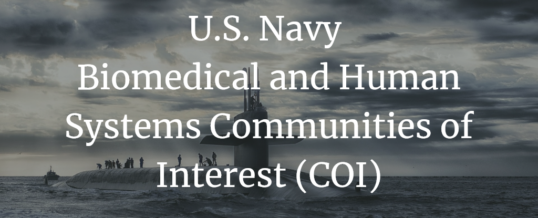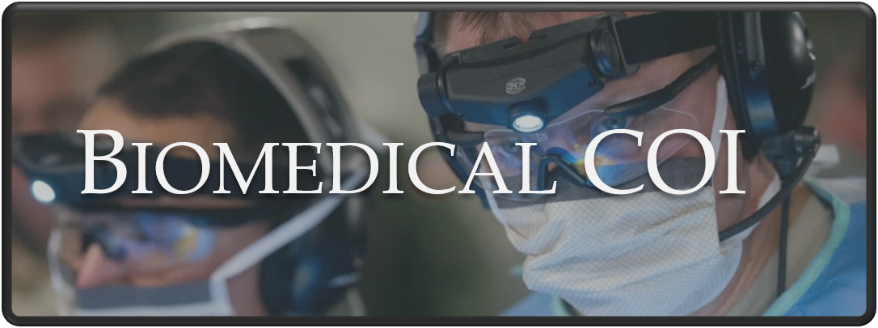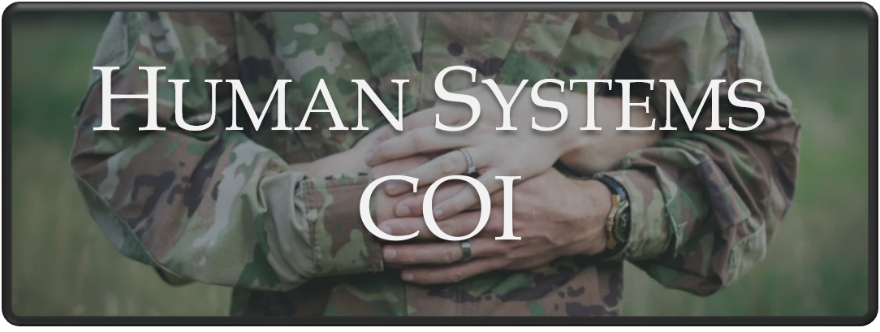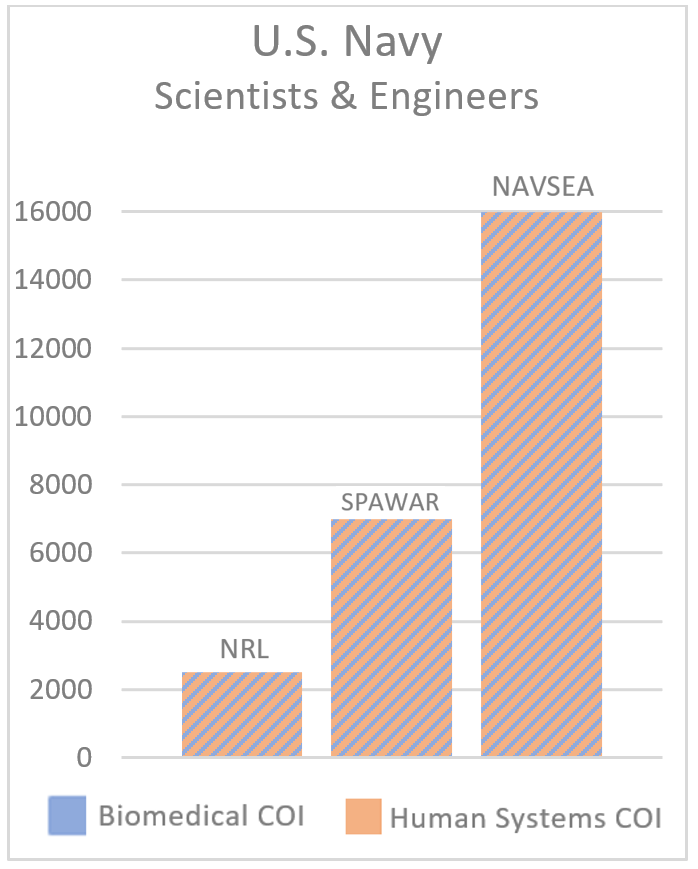
The Department of Defense (DoD) and other military assisting Federal Agencies have a large and diverse community of subject matter experts (SME) who are eager to collaborate with industry and universities. These extraordinary SMEs are driven to accelerate new and novel dual-use technologies forward to clinical and operational settings. There are thousands of healthcare providers in 167 DoD medical treatment facilities within the U.S. (59 Navy MTFs); tens of thousands of researchers in the Defense Research Laboratories; twelve DoD Federally Funded Research and Development Centers (FFRDC) and the 127 DoD Federal Laboratory Consortium (FLC) laboratories; and numerous other locations that we will describe in future articles. Here we will describe U.S. Navy Biomedical and Human Systems Communities of Interest (COI). I am continually amazed at the breadth and diversity of the expertise, resources, and tools available to industry and academic collaborators when teaming with these SMEs in support of and equipping our military personnel, Veterans and their families. Please keep in mind as you read this that Biomedical and Human Systems are only two of many forward leaning Navy COIs.
The DoD Science and Technology (S&T) Communities of Interest (COI) were established in 2009 as a mechanism to encourage multi-agency coordination and collaboration in cross-cutting technology focus areas with broad multiple-component investment. Each COI, as defined by Reliance 21, is led by a steering group of senior technical leaders with common technology interests and consist of subject matter experts (SMEs) from across the DoD. The COI technology areas do not change substantially from year to year. These groups cover 17 technical areas, including Biomedical and Human Systems COIs.

According to the Defense Innovation Marketplace, the Biomedical COI, or Armed Services Biomedical Research Evaluation and Management (ASBREM) COI, promotes the planning and execution of Warfigher Performance and Health Protection initiatives around the globe. It is also meant to coordinate the execution of Research and Engineering and Health Affairs funding for Biomedical Science and Technology and Advanced Development. Army research directorates involved in the Biomedical COI include the Engineer Research and Development Center (ERDC), U.S. Army Aeromedical Research Laboratory (USAARL), Institute of Surgical Research (USAISR), Medical Research Institute of Chemical Defense (USAMRICD), Medical Research Institute of Infectious Diseases (USAMRIID), Research Institute of Environmental Medicine (USARIEM), and the Walter Reed Institute of Research (WRAIR).
The Biomedical COI has seven technical sub-groups:
1. Biomedical Informatics/Health Information Systems & Technology (BI/HIST)
Medical Simulation and Training Research:
• Combat Casualty Training
• Medical Readiness Training
• Health Focused Education
• Tools for Medical Education
Health Informatics Research:
• Theater/Operation Medicine
• Health Services and Population Health
• Health Operations Resourcing and Enterprise Infrastructure Management
2. Military Infectious Diseases (MID)
Plans, coordinates, and oversees infectious disease research and development leading to effective, improved means of protecting the Warfighter against naturally occurring, known, predictable, endemic disease threats.
3. Military Operational Medicine (MOM)
• Psychological Health and Resilience
• Injury Prevention and Reduction
• Environmental Health and Protection
• Physiological Health and Performance
4. Combat Casualty Care (CCC)
• Traumatic Brain Injury (TBI) and Hemorrhage Control
• Resuscitation and Blood Products
• Enroute Care and Forward Surgical Critical Care
5. Medical Radiological Defense (MRD)
Current principal focus is research and development of medical countermeasures to prevent or treat the effects of Acute Radiation Syndrome (ARS).
6. Clinical and Rehabilitative Medicine (CRM)
• Neuromusculoskeletal Injury (prosthetics, assistive devices, and rehabilitation and reintegration strategies)
• Pain (battlefield, acute and chronic)
• Regenerative Medicine
• Sensory Systems (vision, hearing, and balance)
7. Medical Chem-Bio Defense (MCBD)
Plans, coordinates, and oversees research, development, testing, and evaluation of vaccines, therapeutics, and diagnostics against chemical and biological threats.

The Human Systems COI aims to develop and deliver new human-centered technologies to quantify mission effectiveness and to select, train, design, protect, and operate for measurably improved mission effectiveness. In the U.S. Army, several components of the Research, Development and Engineering Command (RDECOM) are actively involved in the Human Systems COI. These include the Armament Research, Development and Engineering (RD&E) Center (ARDEC), Aviation and Missile RD&E Center (AMRDEC), Communications Electronics RD&E Center (CERDEC), Edgewood Chemical Biological Center (ECBC), Natick Soldier RD&E Center (NSRDEC), and the Tank Automotive RD&E Center (TARDEC). Other Army labs involved in the Human Systems COI are the Engineer Research and Development Center (ERDC) and the Army Research Institute for the Behavioral and Social Sciences (ARI).
The Human Systems COI has four technical sub-areas:
1. Personalized Assessment, Education, and Training
• Secure, Large-Scale Live, Virtual, and Constructive (LVC) Joint/Coalition Training Environments
• Individually Tailored Training and Education
• Persistent, Interoperable Learning “Ecosystem”
• Optimal Cross-Career Talent Assessment and Management
2. Protection, Sustainment, and Warfighter Performance
• Real-Time Monitoring of Warfighter Performance with Individualized Optimization
• Warfighter Off-loading Technologies and Augmentation Devices/Exoskeletons
3. Human Aspects of Operations in Military Environments
• Mastering the Information Environment
• Mitigate Threats by Forecasting Indicators and Warnings of Human Intent
4. System Interfaces & Cognitive Processes
• Intuitive Human-Machine Interaction with Natural Interfaces
• Seamless Teaming of Autonomous and Manned Systems
• Cognitive Status Assessment with Adaptive Aiding
U.S. Navy Research Personnel
The Naval Sea Systems Command (NAVSEA) has approximately 74,000 civilian, military and contract support personnel across eight Naval Surface Warfare Centers (NSWCs) and two Naval Undersea Warfare Centers (NUWCs), each with between 1,000 to 5,700 scientists and engineers (S&E) involved in both the Biomedical and Human Systems COIs. As part of the Biomedical COI, the NAVSEA divisions conduct research in BI/HIST (NSWC Carderock and Port Hueneme Divisions); MID (NSWC Indian Head); CCC (NSWC Carderock); and MCBD (NSWC Carderock, Corona, and Dahlgren Divisions). As part of the Human Systems COI, the NAVSEA divisions conduct research in Personalized Assessment, Education, and Training (NSWC Carderock, Corona, Dahlgren, and Indian Head Divisions; NUWC Keyport); Protection, Sustainment, and Warfighter Performance (NSWC Carderock, Dahlgren, and Panama City Division; NUWC Keyport); Human Aspects of Operations in Military Environments (NSWC Port Hueneme, NUWC Keyport); and System Interfaces & Cognitive Processing (NSWC Carderock and Dahlgren Divisions; NUWC Keyport and Newport Divisions).
The Naval Air Warfare Center Aircraft Division (NAWCAD), part of the Naval Air Systems Command (NAVAIR), is involved in the BI/HIST, CCC, and MCBD Biomedical COI technical areas, as well as all four of the Human Systems COI technical areas. The Space and Naval Warfare Systems Command (SPAWAR) has two Centers (SSC-Atlantic and SSC-Pacific) with roughly 3,000 S&E each. Personnel at SSC-Atlantic are involved in the BI/HIST and MOM Biomedical areas, and both centers work on Human Systems areas of Personalized Assessment, Education, and Training (Atlantic), Protection, Sustainment, and Warfighter Performance (Pacific), Human Aspects of Operations in Military Environments (Atlantic), and System Interfaces & Cognitive Processing (Atlantic and Pacific).
The Office of Naval Research (ONR) is responsible for many contract and grant solicitations. ONR is also parent organization to the Naval Research Laboratory (NRL) and the Marine Corps Warfighting Laboratory (MCWL). The NRL, with more than 2,500 researchers, engineers, technicians and support personnel, performs Biomedical research in BI/HIST, MID, MRD, and MCBD; as well as Human Systems research in Protection, Sustainment, and Warfighter Performance, Human Aspects of Operations in Military Environments, and System Interfaces & Cognitive Processing. The MCWL is also involved in both the Biomedical (BI/HIST, CCC, and MOM) and Human Systems COIs (Personalized Assessment, Education, and Training; and Protection, Sustainment, and Warfighter Performance).
What Now?
If you would like more information on how we can assist with identifying and connecting your company to a U.S. Navy or other DoD researcher, please contact us.
24 Apr
2018
